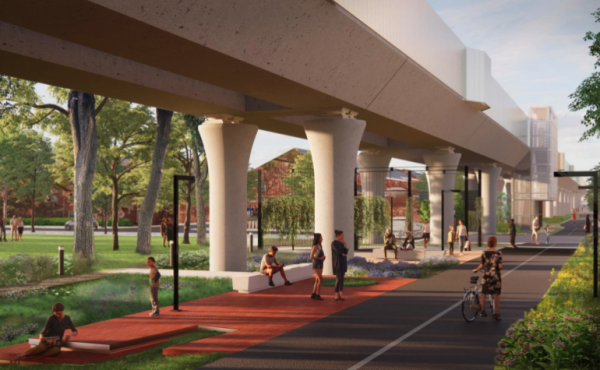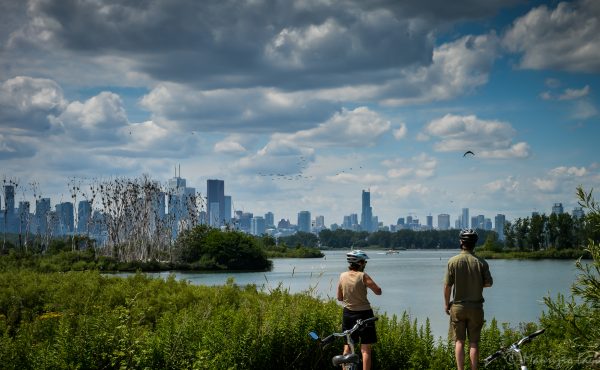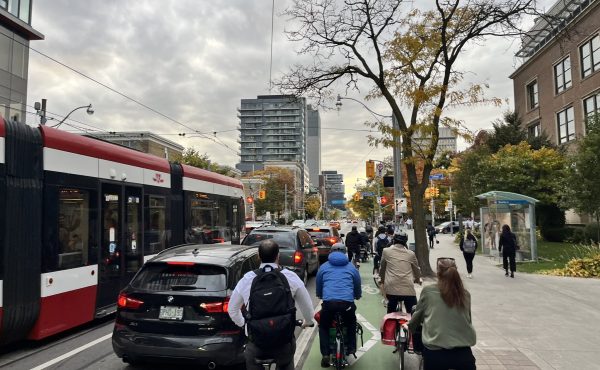
Before the municipal election, the Toronto Coalition for Active Transportation conducted a survey of candidate’s positions on walking and cycling issues. Given the uncertainty created by the change in both mayor and many council positions in the recent election, it’s worth having a look at the responses given by the new council to get a sense of what it might support in terms of walking and cycling improvements.
The new mayor, Rob Ford, did not complete the mayoral survey this election, but he did complete the 2006 councillor survey when he was running in the 2006 election. Although the questions and some of the issues have changed since that election, and he does not provide a lot of commentary, the survey is still illuminating. His positions were reasonably consistent with his overall approach — he is somewhat supportive of generic ideas for improvements in process, very supportive of good maintenance (pedestrian clearways, sidewalk and road maintenance), and opposed to most ideas that involve spending new money or hiring new staff. For bike lanes, he says he will do whatever his constituents support.
In terms of new members of council, the response rate was not all that high — a third of elected councillors responded (candidates do get dozens of survey requests) — but generally fairly positive. Since there is clearly a bias in which the candidates more favourable to active transportation are more likely to reply, possibly the most interesting responses are those from candidates whose position is less predictable.
Peter Milczyn, for example, who is being touted as someone who may have an important role under Ford, gives a mostly positive response. Newly elected Ana Bailão is something of an unknown quantity in terms of her approach to active transportation, but her replies are both detailed and mostly positive (other than opposing the already-established Lansdowne bike lane, unpopular in some parts of her ward).
Here are the responses by winning council candidates:
- Milczyn, Peter
- Nunziata, Frances
- Doucette, Sarah
- Perks, Gord
- Bailão, Ana
- Layton, Mike
- Vaughan, Adam
- Mihevc, Joe
- Wong-Tam, Kristyn
- McConnell, Pam
- Fragedakis, Mary
- Fletcher, Paula
- Davis, Janet
- McMahon, Mary-Margaret
- De Baeremaeker, Glenn
TCAT also did a survey of school trustee candidates — schools have a very important role to play in enhancing walking and cycling in the city. The response rate was not great, but a few of the successful candidates did respond thoughtfully (e.g. Chris Bolton).
I haven’t gone through all of the responses in detail — possibly some of our readers may want to check out their councillor and/or trustee and analyze their response in the comments.
photo by Aubrey Arenas




5 comments
Sandra Bussin, in a desperate attempt to scare away voters from Mary-Margaret McMahon, labelled her as a Conservative who would ultimately support Rob Ford should he win the mayoralty. Reading through Mary-Margaret’s responses (and not being at all suprised, having known her now for several years), it is obvious that Ward 32 is well represented by a truly progressive councillor.
As one of her constituents, from what I was able to glean from her campaign material and media coverage, McMahon strikes me as being in the Green Party mould — an environmentalist but a fiscal progressive.
Sorry — that should read “a fiscal conservative”.
Ana Bailão, Ward 18 (former Giambrone turf) generally has good answers. But If you look deeper:
She says that the Bike Plan will be completed by 2012. Wow, that would be great, but also very wishful thinking…
This also conflicts with her other answer that she does NOT support the Lansdowne bike lanes. For what it’s worth, these bike lanes were approved by PW, community council, and City Council earlier this year, and have been in the Bike Plan forever…
During the final moments of the election campaign, she flyered the area near the existing Dupont St. bike lanes (Dundas to Lansdowne) with promises to have those bike lanes removed.
“I strongly support increasing the number of bike lanes in Toronto, and there is currently a dramatic need for a fast and efficient East-West bike route to cross our city.” So she will do this by taking away the existing Dupont St. bike lane at the top of our ward, which is the start of the well-used Dupont/Annette corridor from Lansdowne to the Humber, with other major connections along the way??
So, it seems that she’s giving “good” answers to the TCAT survey, but is also promising to work against those answers.
Should be interesting to see how this pans out…
The Dupont bike lane really makes the area just east of Dundas feel so much safer when I’m cycling. The road has an unusual twist as it descends into its overpass if you’re heading east from Dundas. There’s also a short connecting road right before the railway underpass that feeds into Dupont. It’s a situation that doesn’t make it easy for drivers to be careful around a cyclist, because there are so many other unusual features of the road.
The bike lane is a critical safety feature in that location. It slows down cars and gives drivers more reaction time and provides more room between them and cyclists. The addition time and space allows drivers to concentrate on the unusual road conditions. A cyclist was killed at the underpass several years ago when he was hit by a car. I think the bike lanes will greatly reduce the risk of similar deaths.